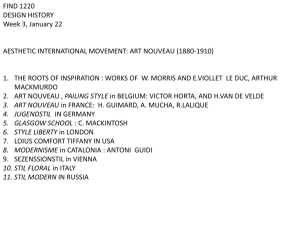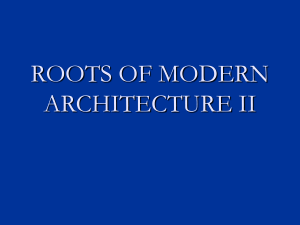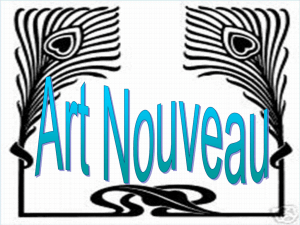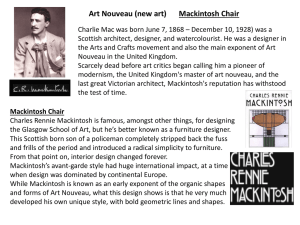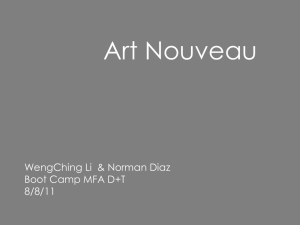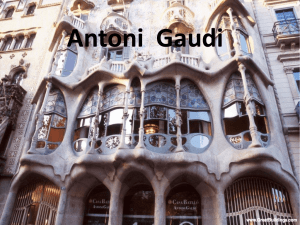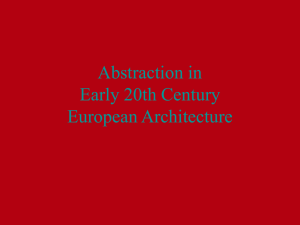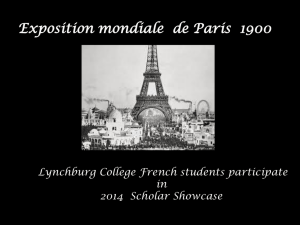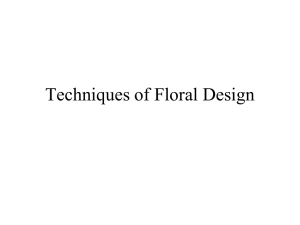Art Nouveau - Duncanrig Secondary School
advertisement
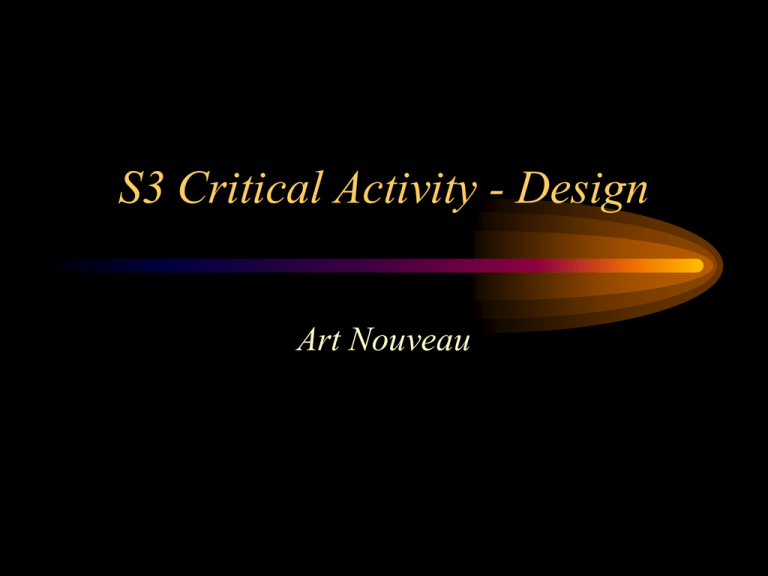
S3 Critical Activity - Design Art Nouveau Introduction to Art Nouveau • Art Nouveau translates as ‘New Art’ in French. • It began in the late 1880’s. • It began in Britain before spreading to Europe and America. • The name came from a Parisian shop owned by Samuel Bing – ‘La Maison de l’Art Nouveau’. • The shop imported Japanese art and sold the work of contemporary designers and sculptors. • It was not a formal movement at the time – it is only with hindsight that links and common characteristics can be established. • The movement introduced the idea of ‘Total Art’ in its architecture –designing everything in the same style. Art Nouveau Influences • The distinctive Art Nouveau style took its inspiration from a variety of sources – nature, early Celtic art and Japanese art. • Common motifs were flowers, stems, leaves, serpents and dragonflies. • Celtic art influenced with its twisting and curving decoration. • Japanese art influenced with its emphasis on decorative line, creating flat patterned work with a delicate balance between decoration and plain background. • “…not mere first-hand copying of nature, but an independent world of imaginative creation where Nature supplied only the raw material.” Masini, p.58 Japanese Art • • • • • ‘The Great Wave’ Hokusai Decorative line Flat colour Sweeping curves Celtic Art • Typical example of Celtic Art. • Intricate. • Interwoven lines. • Natural forms. • Mystical qualities. Characteristics of Art Nouveau • Art Nouveau designs are easily recognised by the designer’s use of line – flowing, curving, twisting and elegant lines. • The designers rejected the use of straight line and order in favour of more natural movement. • The same is true of 3D designs, except the term to use is form rather than line. • The natural influences used are either depicted realistically or in abstracted shapes. • ‘Abstracted’ means the designers stylized and exaggerated natural forms. • There is an emphasis on decorative pattern. Art Nouveau Designers • • • • Alphonse Mucha – a French poster designer and architect, Antoni Gaudi – a Spanish architect, Rene Lalique – a French jeweller and glass designer, Charles Rennie Mackintosh – a Scottish architect and designer, • Victor Horta – a Belgian architect, • Hector Guimard – a French architect and designer. • The leading designers of the movement were most commonly architects, who branched out into designing their own furniture for the interiors of their buildings. This demonstrates the ‘Total Art’ concept of the movement. Alphonse Mucha – 1860-1939 • Mucha was a French poster designer and illustrator of the Art Nouveau period. • Many of these designs were for luxury products like champagne and dance shows. • The female form was the basis of most of his designs. • He exaggerated and elongated the forms and shapes. • The way he stylised the women gave them an air of allure and mystery. • The importance of line is easily seen here. Antoni Gaudi – 1852-1926 • Casa Mila, Barcelona. • Most of Gaudi’s great creations are in Barcelona. • The way the building has been designed and built manages to make it look as though it is one massive living form. • The façade ripples and undulates. It is on a corner site and continues seamlessly around the bend. • This is obviously an Art Nouveau building with its clear references to nature and decorative, twisting ironwork. Antoni Gaudi • This close up allows us to see how the building may have been constructed more easily. Antoni Gaudi • This photograph from the roof allows us to see the courtyard in the centre of the building. Antoni Gaudi • Casa Batllo, Barcelona • This is one of Gaudi’s most spectacular and unusual buildings. • Brightly coloured ceramic disc shaped tiles have been used to cover the façade. • The sandstone used for the windows has been moulded and sculpted into elongated, curving openings for the windows. Antoni Gaudi • The roof, also covered with bright ceramic tiles, has been designed to echo the scales on a dragon’s back. • The roof is almost sculptural and showcases Gaudi’s all round talent as an artist and architect. • The building is a perfect blend of aesthetics (appearance) and function (purpose). Antoni Gaudi • Casa Batllo, Barcelona • This apartment block is known locally as the ‘House of Yawns’. • Gaudi has been interested in function here as he would have ensured the building worked as an apartment block. • However, he has also been interested in the form and aesthetics. • This is easily seen in the verandas and the way he has cleverly combined the stonework with iron bars for safety. Antoni Gaudi • Casa Batllo, Barcelona • Gaudi has been highly imaginative in his use of materials. • In this one window, we can see stonework, metalwork and coloured glass panels. • To really understand how unusual this building is, compare it to any you have seen in Scotland. Have you seen anything similar? Antoni Gaudi • Guell Palace, Barcelona • Arched entrances • Decorative ironwork • Both key characteristics of the Art Nouveau style. Rene Lalique – 1860-1945 • Peacock Brooch, c.1898/1900 • Gold, enamel, opals, diamonds. • Lalique was a master goldsmith who is seen as revolutionary. • He did not use materials traditionally and rarely used diamonds - unusual at this time. • The use of non-precious coloured stones, glass and tortoiseshell led the way for costume jewellery later in the Art Deco era of the 1920’s. Rene Lalique • Landscape comb, c.1899/1900 • Enamelled gold and horn. • Enamel was also rare at this time, but Lalique loved the bright yet delicate colours. Rene Lalique • Serpent brooch, c.1898/1899 • Gold and enamel • Lalique frequently used dragonflies, serpents, peacocks and graceful women as his source material. • These share an exotic aura of mystery. Rene Lalique • Dragonfly brooch. • Gold and enamel. • This is possibly Lalique’s most well-known piece. • The enamel has been delicately used to create the shimmering colours in the wings. • Lalique’s imagination is clear in this design which incorporates claws and a female form in the centre of the dragonfly. Rene Lalique • Face pendant. • Gold, silver, glass, enamel, pearl. • He was very observant and very skilled. • This is easily seen in the intricate detail of his work. • Lalique began experimenting with glass in the 1920’s. C.R. Mackintosh - 1868-1928 • Mackintosh’s style is ‘Art Nouveau’, but his work is not exactly like the other designers. • He was not very well regarded in his lifetime, particularly in England where they viewed his work as too stylised or aesthetic. • Mackintosh used more measured, elegant curves then the others, whose lines are sometimes termed ‘whiplash’. C.R. Mackintosh • 78 Southpark Avenue, remodelled at The Hunterian Gallery, Glasgow • This project was an opportunity to create ‘interior architecture’ – designing everything within the house to create a harmonious interior. • The simplicity and use of the colour white was very unusual at this time, particularly in such an industrial city as Glasgow. • Again, CRM has carefully blended decoration and function. C.R. Mackintosh • Doors for the Salon de Luxe, Willow Tea Rooms, Glasgow, 1903. • Stained Glass. • Symmetry was common in Mackintosh designs. • Clear evidence of natural influences and fascination with line. • Again, very functional as this door would signal an entry into a more specialised area of the Tea Rooms. C.R. Mackintosh • Cabinet with inlaid glass panels, for 14 Kingsborough Gardens, Glasgow. • The decorative stained glass side panels were possibly a result of collaboration with his wife. • Stained glass was ideal for Art Nouveau designers to use as it is quite easy to produce and allowed them to use line and colour in a flat decoration. C.R. Mackintosh • Hillhouse Chair • This is one of Mackintosh’s most famous designs. • This was produced later in his life and the difference from earlier work is obvious. • The design is still very linear, but much more simple and restrained. Victor Horta – 1861-1947 • Hotel Tassel, Brussels • They all made use of wrought iron in their work as it is very versatile, appropriate for both structural and decorative uses. • This reception area makes good use of the material. • “The effect is one of great decorative fantasy” p.105, Masini text. Victor Horta • Horta has left the load-bearing columns exposed, making them become a decorative feature. • This was a common trait in Art Nouveau - making structural features appear ornamental. • Horta has echoed the curves in the balustrading with the curved stairs, tiled mosaic floor and the painted wall designs. • Again, this is the way Art Nouveau designers worked creating a uniformity in the interior. Victor Horta • The use of large areas of glass and the linear iron supports allows for a delicate, almost transparent approach. Hector Guimard – 1867-1942 • Guimard was also an architect, but like the other designers was interested in designing furniture too. • This is perhaps because they liked to have the same control over their interiors as they did over the exterior of a building. • Guimard’s style is very curvilinear - no straight lines. Hector Guimard • French Pearwood chair • The same ideas apply to designing furniture as buildings- form and function, ornament and structure. Hector Guimard • Guimard is responsible for the Metro station entrances in Paris. • He also designed the distinctive lettering style, which many people disliked at first. • The entrances generally made use of wrought and cast irons, which could be manipulated into sweeping curves. Hector Guimard • Decorative ironwork at a Paris metro • The green enamel work here is reminiscent of real plant life. • No other designer in France reached the same level of decorative freedom as Guimard during the Art Nouveau period. Bibliography • Books • Websites • ‘Design Museum - 20th Century Design’ Catherine McDermott • ‘The Look of The Century’ Michael Tambini • ‘Art Nouveau Architecture’ Frank Russell (Ed.) • ‘Introduction to the Decorative Arts’ Amanda O’Neill (Ed.) • ‘Art Nouveau’ Lara Vinca Masini • ‘Gaudi’ Juan-Eduardo Cirlot • • • • • • www.kubos.org/AN/en www.artcyclopedia.com www.crmsociety.com www.artlex.com www.greatbuildings.com www.dogpile.com (search engine) • www.nga.gov (Search, Search the site, Art Nouveau) • Thank you for your attention. You will be able to access this presentation on the school network in the ‘Shared Documents – All Users’ area to note any further information you need.
